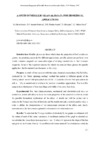Identificador persistente para citar o vincular este elemento:
https://accedacris.ulpgc.es/jspui/handle/10553/105997
| Título: | A study of metallic glass Al93Ti3Cr2Fe3 for biomedical applications | Autores/as: | Florido Suárez, Néstor R. Mirza Rosca, Julia C. Socorro Perdomo, Pedro Pablo Brito García, Santiago J. |
Clasificación UNESCO: | 3314 Tecnología médica | Palabras clave: | Metallic glass Tensile strength Corrosion |
Fecha de publicación: | 2021 | Editor/a: | Bandirma Onyedi Eylul University | Conferencia: | International Symposium of Scientific Research and Innovative Studies (ISSRIS 2021) | Resumen: | Introduction: Metallic glasses are those which share the properties of both metals and glasses. As promising materials for different applications, metallic glasses are preferred over metals, ceramics, magnetic and some other types of existing materials due to their enhanced properties. Some of the important reasons for which we consider these glasses for specific application like biomaterials are discussed in this study. Purpose: A study of two samples with the same chemical composition, Al93Ti3Cr2Fe3, produced by the "Metal spinning cooling" method but cooled at different speeds of the rotating wheel: one at 1700 rpm (which we call Al - 17) and the other at 2500 rpm (which we call Al - 25), is carried out to evaluate the possible biomedical applications. The thin film samples have thicknesses of less than 20µm and widths of no more than 5mm. Experimental: For their characterization, mechanical and electrochemical tests are carried out, which will allow to know the main properties of the material in order to decide the possible biomedical applications of the alloys. A tensile test will be carried out to calculate the Young's modulus of elasticity and the tensile strength, a metallographic study in order to define the characteristics of the microscopic structure of the alloys and, finally, corrosion tests, for the corrosion potential and corrosion rate determinations. Results: To calculate the Young's modulus of elasticity E, the graphs are obtained with the values of each of the tested specimens. A rectilinear section of the graph is selected and we calculate the linear dispersion equation y = ax + b where 'a' represents the slope of the line and gives us the E value. Finally, the coefficient of determination R2 is calculated to verify the International Symposium of Scientific Research and Innovative Studies, 22-25 February 2021 238 optimality of the model used. In all cases the value of R2 is above 0.99 so we can say that the model fitts more than 99% of the calculated variable. The corrosion tests are performed in Ringer's solution, which simulates the physiological fluid of the human body. An open circuit potential test is performed and the evolution of the potential E is represented with respect to time and the profile of the obtained curve will allow us to know the tendency to passivation or to corrosion of each sample. A linear polarization is performed on each specimen in the electrolytic cell. The data are processed in the Ec-Lab program obtaining the values of corrosion current Icorr and the Tafel coefficients βa and βc from which the corrosion rate is calculated in mmpy. Conclusions: The values of the tensile strength σten can be considered low in comparison with other alloys used as titanium-based biomaterials or stainless steels, although in none of the two metallic glass samples studied is this value lower than that of cortical bone (50 - 150 MPa). To highlight the average value obtained for the σten for the Al-25 sample, which is of the order of 2.2 times that of Al-17. In all the microphotographs taken of the metallic glass samples, without attack and with the attacks carried out with hydrofluoric acid, a non-crystalline structure is observed, as is to be expected in a material with a glassy structure. The samples studied show good corrosion behavior, although they show a notable increase in corrosion rate when tested at body temperature (40ºC). Comparing the corrosion rate between the samples Al-17 and Al-25 at each temperature analyzed, it is observed that Al-17 at room temperature has a corrosion rate increase of about 4.5 times with respect to the corrosion rate of Al-25. It is concluded that the Al-25 sample presents a better behavior as biomaterial due to the higher mechanical resistance, a low Young's modulus and a lower corrosion rate. The metallographic study confirms the amorphous structure of the samples, in none of the micrographs crystalline structures are observed. | URI: | https://accedacris.ulpgc.es/handle/10553/105997 | ISBN: | 978-625-44365-8-1 | Fuente: | International Symposium of Scientific Research and Innovative Studies - ISSRIS21. Abstracts book / Muhammet Nuri SEYMAN; Cemil KÖZKURT; Adem DALCALI (eds.), p. 237-238 |
| Colección: | Actas de congresos |
Visitas
407
actualizado el 15-ene-2026
Descargas
120
actualizado el 15-ene-2026
Google ScholarTM
Verifica
Altmetric
Comparte
Exporta metadatos
Los elementos en ULPGC accedaCRIS están protegidos por derechos de autor con todos los derechos reservados, a menos que se indique lo contrario.
